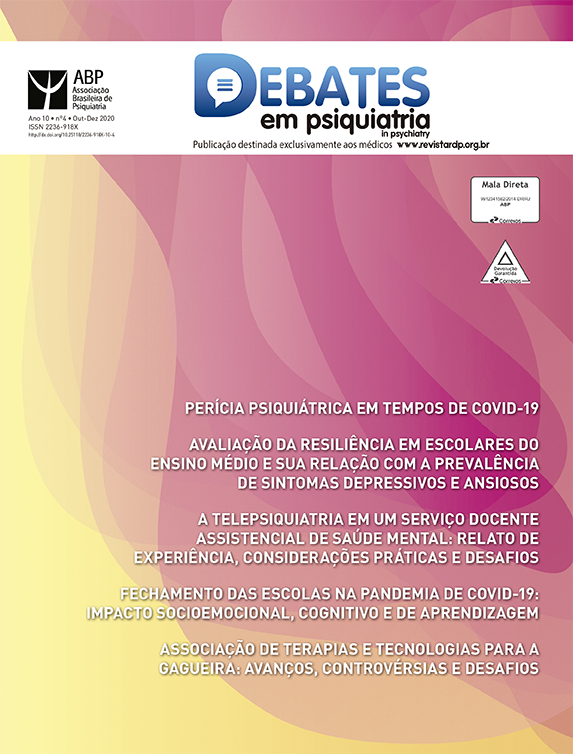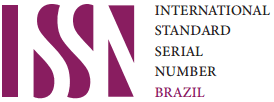Associação de terapias e tecnologias para a gagueira: avanços, controvérsias e desafios
DOI:
https://doi.org/10.25118/2763-9037.2020.v10.22Palavras-chave:
Gagueira, tratamentos, tecnologiaResumo
No presente trabalho, discutimos como o uso associado de tecnologias, como a realidade virtual, com abordagens de tratamentos modernas, como a terapia cognitivocomportamental (TCC) associada ao mindfulness, pode contribuir para resultados mais eficazes no tratamento da gagueira. Os antigos tratamentos focados unicamente em terapia comportamental, com uso prioritário da terapia de exposição, foram sendo substituídos e/ou associados a novas abordagens, utilizando a TCC como base do processo de tratamento. Atualmente, protocolos que visam difundir o uso de tecnologias de realidade virtual, videogames e estimulação transcraniana com esse novo foco terapêutico expandido, tendo por objetivo a diminuição da ansiedade antecipatória/social, juntamente com o ganho de atenção plena e de percepção de gatilhos internos e externos de ansiedade, estão mudando de maneira bastante consistente o panorama do tratamento da gagueira. Neste artigo, vamos considerar diversos trabalhos seminais e novos que demonstram que tecnologias de simulação de situações de vida real são as práticas que têm obtido os melhores resultados no tratamento da gagueira.
Downloads
Métricas
Referências
Marengo L, Ferreira LN, Rivero TS, Godoy JC. A critical view of a treatment intervention for stuttering based on video games. Int J Psychol Neurosci. 2015;2:235-50.
Lavender TJ, Gromala D. Audition, the game. Procedia Comput Sci. 2012;15:187-92. DOI: https://doi.org/10.1016/j.procs.2012.10.070
American Psychiatric Association. Diagnostic and Statistical Manual of Mental Disorders, Fifth Edition (DSM-5). Arlington: American Psychiatric Publishing; 2013. DOI: https://doi.org/10.1176/appi.books.9780890425596
Perez HR, Stoeckle JH. Stuttering: clinical and research update. Can Fam Physician. 2016;62:479-84.
Walsh B, Mettel KM, Smith A. Speech motor planning and execution deficits in early childhood stuttering. J Neurodev Disord. 2015;7:27. DOI: https://doi.org/10.1186/s11689-015-9123-8
The Stuttering Foundation. Electronic devices, software and Apps [Internet]. 2019 [cited 2020 Oct 13]. www.stutteringhelp.org/electronicdevices-software-and-apps
Fernández-Zúñiga A, de León M. Conceptos básicos y abordaje de la tartamudez. FMC. 2011;18:193-9. DOI: https://doi.org/10.1016/S1134-2072(11)70081-0
Reilly S, Onslow M, Packman A, Cini E, Conway L, Ukoumunne OC, et al. Natural history of stuttering to 4 years of age: a prospective community-based study. Pediatrics. 2013;132:460-7. DOI: https://doi.org/10.1542/peds.2012-3067
McAllister J, Collier J, Shepston L. The impact of adolescent stuttering and other speech problems on psychological well-being in adulthood: evidence from a birth cohort study. Int J Lang Commun Disord. 2013;48:458-68. DOI: https://doi.org/10.1111/1460-6984.12021
Felsenfeld S, Kirk KM, Zhu G, Statham DJ, Neale MC, Martin NG. A study of the genetic and environmental etiology of stuttering in a selected twin sample. Behav Genet. 2000;30:359-66. DOI: https://doi.org/10.1023/A:1002765620208
Craig A, Tran Y. Trait and social anxiety in adults with chronic stuttering: conclusions following meta-analysis. J Fluency Disord. 2014;40:35-43. DOI: https://doi.org/10.1016/j.jfludis.2014.01.001
Helgadottir FD, Menzies RG, Onslow M, Packman A, O’Brian S. A standalone Internet cognitive behavior therapy treatment for social anxiety in adults who stutter: CBTpsych. J Fluency Disord. 2014;41:47-54. DOI: https://doi.org/10.1016/j.jfludis.2014.04.001
Brignell A, Krahe M, Downes M, Kefalianos E, Reilly S, Morgan AT. A systematic review of interventions for adults who stutter. J Fluency Disord. 2020;64:105766. DOI: https://doi.org/10.1016/j.jfludis.2020.105766
Mongia M, Gupta AK, Vijay A, Sadhu R. Management of stuttering using cognitive behavior therapy and mindfulness meditation. Ind Psychiatry J. 2019;28:4-12. DOI: https://doi.org/10.4103/ipj.ipj_18_19
Boyle MP. The impact of causal attribution on stigmatizing attitudes toward a person who stutters. J Commun Disord. 2016;60:14-26. DOI: https://doi.org/10.1016/j.jcomdis.2016.02.002
Rodríguez-Carvajal R, Moreno-Jiménez JE, García-Rubio C, Castillo R, Montero I. Efectos del entrenamiento breve en mindfulness en tartamudez: un estudio de caso único [Intetrnet]. 2017 [cited 2020 Oct 13]. blogs.ua.es/aesppu/files/2017/10/13Me14-Tartamudez.pdf
Harley J. The Role of attention in therapy for children and adolescents who stutter: cognitive behavioral therapy and mindfulnessbased interventions. Am J Speech Lang Pathol. 2018;27:1139-51. DOI: https://doi.org/10.1044/2018_AJSLP-ODC11-17-0196
Beilby JM, Byrnes ML, Yaruss JS. Acceptance and commitment therapy for adults who stutter: psychosocial adjustment and speech fluency. J Fluency Disord. 2012;37:289-99. DOI: https://doi.org/10.1016/j.jfludis.2012.05.003
De Veer S, Brouwers A, Evers W, Tomic W. A pilot study of the psychological impact of the mindfulness-based stress reduction program on persons who stutter. Eur J Psychother Couns. 2009;9:39-56.
Ingham RJ, Ingham JC, Bothe AK, Wang Y, Kilgo M. Efficacy of the modifying phonation intervals (MPI) stuttering treatment program with adults who stutter. Am J Speech Lang Pathol. 2015;24:256-71. DOI: https://doi.org/10.1044/2015_AJSLP-14-0076
Chesters J, Möttönen R, Watkins KE. Transcranial direct current stimulation over left inferior frontal cortex improves speech fluency in adults who stutter. Brain. 2018;141:1161-71. DOI: https://doi.org/10.1093/brain/awy011
Rivero T. A construção de um método para o desenvolvimento de um videogame para treino de controle inibitório para adolescentes com transtorno do déficit de atenção e hiperatividade [dissertation]. São Paulo: Universidade Federal de São Paulo; 2016.
Baranowski T, Buday R, Thompson D, Lyons EJ, Lu AS, Baranowski J. Developing games for health behavior change: getting started. Games Health J. 2013;2:183-90. DOI: https://doi.org/10.1089/g4h.2013.0048
Rivero TS, Núñez LM, Pires EU, Bueno OF. ADHD rehabilitation through video gaming: a systematic review using PRISMA guidelines of the current findings and the associated risk of bias. Front Psychiatry. 2015;6:151. DOI: https://doi.org/10.3389/fpsyt.2015.00151
Scheurich JA, Beidel, DC, Vanryckeghem M. Exposure therapy for social anxiety disorder in people who stutter: an exploratory multiple baseline design. J Fluency Disord. 2019;59:21-32. DOI: https://doi.org/10.1016/j.jfludis.2018.12.001
Klinger E, Bouchard S, Légeron P, Roy S, Lauer F, Chemin I, et al. Virtual reality therapy versus cognitive behavior therapy for social phobia: a preliminary controlled study. Cyberpsychol Behav. 2005;8:76-88. DOI: https://doi.org/10.1089/cpb.2005.8.76
Downloads
Publicado
Como Citar
Edição
Seção
Licença

Este trabalho está licenciado sob uma licença Creative Commons Attribution-NonCommercial 4.0 International License.
Debates em Psiquiatria permite que o (s) autor (es) mantenha(m) seus direitos autorais sem restrições. Atribuição-NãoComercial 4.0 Internacional (CC BY-NC 4.0) - Debates em Psiquiatria é regida pela licença CC-BY-NC
































